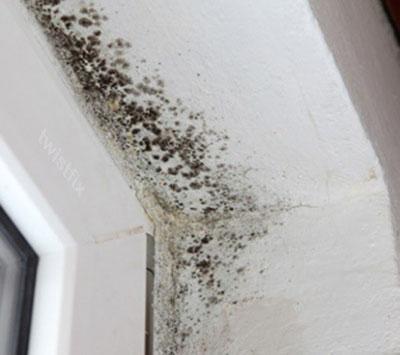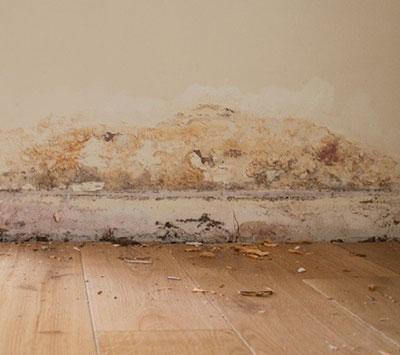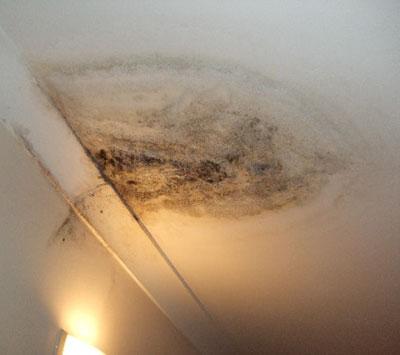We take damp and mould in residents' homes very seriously. Find out what we are doing to tackle damp and mould in council properties.
While serious damp and mould can be harmful to health, it is also important to remember that not all damp or mould is dangerous.
Damp and mould in homes can get worse in cold weather especially when homes fall below a certain temperature due to heating not being used or not being effective. If you are struggling with your energy costs, please see our Haringey, Here to Help webpages.
Definitions
Mould
Mould can be caused by condensation or damp. Mould grows and multiplies in moist areas, slowly at first, then quicker. In most cases black mould is caused by condensation.

Condensation
Condensation comes from the moisture in the air in your home, this can be caused by leaks but also increased by cooking, cleaning, bathing, and even breathing. Condensation will form on the coldest surfaces in your home, these cold areas are usually around windows, the corners of the room, and external walls.
Condensation often occurs during cold weather. It isn't necessarily a problem, as long as the surface has time to dry out every day.
Damp
There are many forms of damp.
Rising damp
Rising damp is when moisture is able to travel into your home from outside (just above ground level) and may result in damp up to 1 metre high above the ground floor.

Penetrating damp
Penetrating damp is caused when water soaks a wall and travels through into your home. This may be caused by leaks, flooding or defective guttering and seals around your bath, shower, basin and sink.

The most common form of damp is from condensation and, from time to time, particularly in colder months, affects most homes in the UK. Damp occurs in moist places that may never fully dry out, usually where there is little air movement.
Reporting damp and mould in your home
Haringey Council tenants
If you have a problem with damp and mould and have not yet reported it to us, or we have not yet been touch, please fill in our online form:
You can also:
- email us at dampandmould@haringey.gov.uk with your full address including the postcode, as well as your full name and a contact phone number. Please provide photos of the affected areas if you can
- phone us on 020 8489 5611
If you have already reported a problem and we are dealing with it (for instance, we have said that we will visit your property to undertake a ‘mould-wash’), you do not need to report it again unless it has got worse since we last visited your home.
Haringey Council leaseholders
Damp and mould in your property is your responsibility, unless it is caused by a building defect; or as result of a leak from a neighbouring property.
If you believe this is the reason for damp and mould in your property, please contact us via our leasehold repairs page.
Temporary accommodation
Temporary accommodation can be owned and managed by the council, a housing association or by a private landlord. You can find this information on your licence or tenancy agreement.
- If your agreement is with Haringey Council, please use our online housing reporting service or call 020 8489 5611
- If your agreement is with a housing association, please contact their repairs line
- If you have a licence agreement, please contact the accommodation provider named on the agreement directly
If you are not sure please contact us in the first instance on 020 8489 5611.
Housing association tenants
It is your landlord’s legal duty to deal with disrepair and housing safety in their properties. If you have complained to your housing association but they have not dealt with your damp or mould problem, you can contact our private sector housing team and we will investigate it for you.
Tenants of a private landlord
Your landlord is under a duty to fix problems in your home. You should report problems of damp and mould to them immediately.
Housing charity Shelter provides some clear and helpful advice about what to do if you have damp and mould in your privately rented home.
If your landlord does not take effective action to deal with a problem you are having you can raise your concerns with our Private Sector Housing team and we will investigate it for you.
Help and advice
There are a number of things you can do to minimise the risk of mould in your home. We recognise not all of these steps will be possible in all circumstances. It is possible that you may be taking all the actions below and still have mould in your home.
Minimise the amount of moisture in your home
- Dry clothes outside where possible, or in a room (preferably the bathroom) with a window open, or extractor fan running, and doors closed. Only use a tumble dryer if it is venting outside or has a condenser.
- Try not to put wet clothes on a radiator - they fill the room with moisture.
- Keep lids on saucepans when cooking and ventilate the room and keep your extractor fan on - if you have one.
- Always run the extractor fan - if you have one - or open a window when showering or cooking, and wipe away any excess water on floors, tiling and worktops.
- Trickle vents must remain open (the small vents on windows and doors) if you have them.
Improve air movement around areas prone to mould
- Pull furniture away from walls, including beds, where this is possible.
- Keep air bricks and vents open and clear.
- Don't add a seal to kitchen and bathroom windows or to windows in rooms that are prone to damp.
- If possible, open windows regularly to increase ventilation and air your home.
Minimise the number of cold surfaces by heating your home to a reasonable level of warmth
It’s recommended to keep rooms heated to at least 16 degrees during the day. This will reduce the chances of damp. If you are struggling with your energy costs, please see our Haringey, Here to Help webpages to see what help is available.
Wipe down condensation from windows and other areas each morning and open windows for a while
Use a cloth or window vacuum cleaner to remove moisture that's formed overnight.
If you have small patches of mould
Use an anti-fungal spray purchased from a hardware shop (or supermarket) to wipe it away. Always follow the instructions on the packaging.
Watch this video for further information how to deal with damp and mould issues in your home: